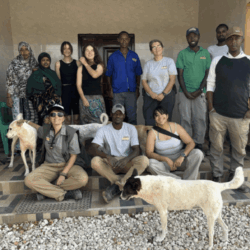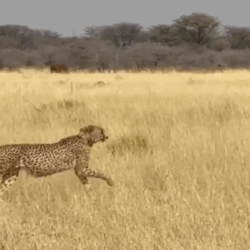How do we track cheetahs in the wild?
-

- by Cheetah Conservation Fund Canada April 29, 2024

Cheetahs have one of the largest home ranges of any animal on earth – sometimes extending up to 2,000 square kilometers (or 800 square miles). However, like many other predators, cheetahs are highly elusive. Yet, knowing their population numbers and distribution is critical for developing effective conservation strategies. While technological tools like camera traps can be used to monitor wildlife populations, one effective way to track cheetahs is using scat detection dogs. In fact, canines have been used to track wildlife since the late 1890s – when dogs were tasked with detecting kakapos in New Zealand, large flightless parrots being decimated by predators introduced to the country.
Not surprisingly, pups are pretty exceptional at finding poop. For starters, dogs can have as many as 250 million olfactory receptors, depending on their breed – while on average, humans have just five million. Beyond their olfactory acuity, dogs are also highly trainable – and many breeds are highly adept at working outdoors, covering significant distances, and navigating natural obstacles. In fact, in one study conducted by CCF researchers during the dry season in Namibia, scat detection dogs found 93.3% of the samples of cheetah scat – 3.5 times as many as the human scat trackers.
In Somaliland, Wildlife Observers have also been equipped with essential skills for identifying tracks and scat left by cheetahs and other carnivores – part of a program funded by the European Union and the Taiwanese Government. And, the Cheetah Rescue and Conservation Centre (CRCC) in Geed-Deeble was an ideal training facility – participating Wildlife Observers learned about signs left in the wild from the Centre’s resident cheetahs. Now, these Wildlife Observers are actively patrolling regional villages, searching for signs of wild cheetahs and recording these observations using mobile devices and the Spatial Monitoring and Reporting Tool (SMART). The data collected by these Wildlife Observers is providing a better understanding of how many wild cheetahs are in the area, their distribution, and what the cats are eating.
"Cheetah Tracks" Newsletter Sign-Up
Stay updated on the activities of Cheetah Conservation Fund in Canada, Namibia and Somaliland. We send semi-annual newsletters and info about special events and initiatives. We will not share your email address with any other organization.
Related Reading
-
November 23, 2025
Canadian Veterinarian Reunites With Rescued Cheetahs – Somaliland



